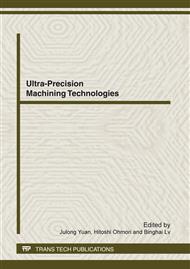p.268
p.273
p.278
p.284
p.289
p.294
p.299
p.304
p.311
FEA on Deformation Behavior of Glass Plate in Elastic Deformation Machining Process
Abstract:
Deformation behavior; Aspheric surface; Finite element method; Contact area Abstract. Elastic deformation machining is a novel processing method for aspheric surface. In the machining process, the workpiece will deform and be in contact with the molded surface once load is applied. In this paper, a finite element model was built with Abaqus/CAE package to predict the deformation behavior of glass plate and some significative conclusions were obtained. The numerical simulation results show that the contact area between the plate and the mold is increasing with different pressure. Once the required pressure value is determined exactly, the glass plate can be deform and completely contact with the mold. The deformed shape of glass plate will completely contact with the mold at pressure p=100kPa. These conclusions have the positive significance for the applying of elastic deformation machining.
Info:
Periodical:
Pages:
289-293
Citation:
Online since:
April 2012
Authors:
Price:
Сopyright:
© 2012 Trans Tech Publications Ltd. All Rights Reserved
Share:
Citation:


